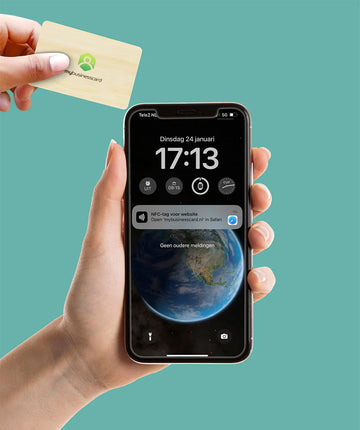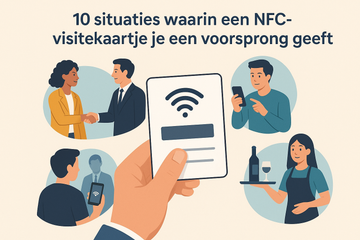Near Field Communication, or NFC, has become indispensable in the modern world. From contactless payments to access passes and information sharing, NFC plays a vital role in our daily lives. But how exactly does this technology work? Which phones does it work on? What's the difference between iPhone and Android? And where exactly is that card reader on your phone? In this blog post, we'll delve into everything you need to know about NFC so you can use it optimally for your digital business cards.
What is NFC technology?
NFC stands for Near Field Communication, a wireless communication technology that allows devices to communicate with each other over short distances (up to about 4 centimeters). It is based on radio waves and works via inductive coupling between two antennas.
The technology is derived from RFID (Radio Frequency Identification), but NFC operates at a much shorter distance and is specifically designed for fast and secure interactions. This makes NFC ideal for applications such as contactless payments, access control, exchanging small amounts of data, and pairing devices.
How exactly does NFC work?
With NFC, two devices communicate via electromagnetic fields. One device generates an electromagnetic field, to which the second device responds. This could be, for example, a smartphone and a payment terminal, or a phone and an NFC chip in an access card.
There are three different ways NFC can work:
-
Peer-to-peer : Two NFC-compatible devices exchange data, for example, to share a photo or contact information. Just like our business cards !
-
Reader/writer mode : A device reads information from an NFC tag, such as an access pass or a product label.
-
Card Emulation : A device behaves like a card, such as a bank card or public transport chip card, allowing you to pay or check in with your phone.
The most well-known application is probably contactless payment, where your phone functions as a digital payment card.
Which phones does NFC work on?
NFC is now a standard feature on almost all modern smartphones, but whether and how the technology can be used varies by make and model.
Android phones
Nearly all Android smartphones released in recent years have NFC built-in. Brands like Samsung, Google Pixel, OnePlus, Huawei, and Xiaomi offer NFC as standard in their mid-range and high-end models. Android often has NFC enabled by default, and you can easily turn it on or off through the settings.
Android offers the most flexibility in using NFC. You can use NFC for payments (like Google Pay), reading and writing NFC tags, sharing files via Android Beam (although this is less common), and emulating maps. With Android devices, you always have the option to enable or disable NFC.
iPhones
Apple only introduced NFC in 2014 with the iPhone 6. Since then, all iPhones from the iPhone 6 onwards have supported NFC, but with a few important limitations:
-
iOS 11 and later : Starting with iOS 11, iPhones can read NFC tags.
-
iPhone 7 and later : Can read NFC tags without opening a special app.
-
From iPhone XS/XR and later : Support for map emulation and more features.
iPhones can use NFC primarily for Apple Pay, reading NFC tags, and since iOS 13, also writing NFC tags. However, access to NFC is more restrictive than on Android, as Apple limits which apps can use the NFC chip. Newer iPhone models almost always have this NFC feature enabled.
What's the best way to scan NFC cards against your phone?
Scanning an NFC card is very simple, but for the best results, here are a few tips:
-
Hold the correct side of the phone against the card
As mentioned, on Android it's usually the back, on iPhone it's the top of the front. -
Make sure the distance is small
NFC works up to about 4 centimeters, but for optimal connection it's better to hold the card almost directly against the phone. -
Avoid metal or thick cases
Metal or thick protective cases can interfere with the NFC signal. If in doubt, it's best to scan the card without the case. -
Wait for confirmation
You will often hear a beep or feel a vibration once the scanning is successful. -
Scan quietly
Hold the card still against the desired spot on the phone. Sometimes you have to experiment a bit to find the right spot. -
Activate NFC if necessary
On some Android phones, you may first need to enable NFC through the settings.
Applications of NFC
In addition to contactless payment and access passes, there are many more useful applications:
-
Digital business cards : Networking is now done with digital business cards, an all-in-one solution and no hassle with paper business cards.
-
Doorbells and access control : Some offices or apartments use NFC cards to open doors.
-
Data sharing : Android Beam was a feature for quickly sharing files via NFC, although this is now being replaced by other technologies.
-
Smart tags : Small stickers or cards with an NFC chip on which you can store a website, contact details or a Wi-Fi password, for example.
-
Ticketing : Concerts, festivals, and events use NFC tickets for quick entry.
Which chip do we use and why?
Mybusinesscard uses the NTAG chip , one of the most reliable and versatile NFC chips on the market. NTAG was developed by NXP Semiconductors, a global leader in NFC technology.
What is an NTAG chip?
The NTAG chip is a special NFC tag designed for fast, secure, and energy-efficient communication. It's a passive chip, meaning it doesn't require its own power source but draws power from the NFC device (such as your smartphone) when you scan it.
What does this mean to you?
-
Widely compatible
NTAG chips are supported by virtually all NFC-compatible smartphones, both Android and iPhone. This allows you to work seamlessly with virtually any modern device. -
Fast and reliable
The communication between the NTAG chip and your phone is smooth and fast, providing a seamless scanning experience. -
Safety
NTAG chips offer good security features, such as password protection, so that sensitive information can be well protected. -
Versatility in storage
These chips can store various types of data and, above all, provide sufficient storage for all your contact details, including company logos. -
Sustainability and reliability
NTAG chips are robust and work well through thin materials such as plastic or paper, which is perfect for business cards that are carried and used frequently.
By choosing NTAG technology, Mybusinesscard guarantees a stable and secure NFC experience, allowing you to easily share your digital business card with anyone, regardless of the type of phone they use.






